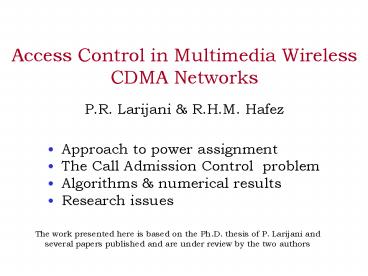Access Control in Multimedia Wireless CDMA Networks - PowerPoint PPT Presentation
1 / 24
Title:
Access Control in Multimedia Wireless CDMA Networks
Description:
CDMA access is characterized by soft capacity. Multi-media = Mixed traffic = different ... M and k run over all terminals of all classes within the cell. ... – PowerPoint PPT presentation
Number of Views:136
Avg rating:3.0/5.0
Title: Access Control in Multimedia Wireless CDMA Networks
1
Access Control in Multimedia Wireless CDMA
Networks
P.R. Larijani R.H.M. Hafez
- Approach to power assignment
- The Call Admission Control problem
- Algorithms numerical results
- Research issues
The work presented here is based on the Ph.D.
thesis of P. Larijani and several papers
published and are under review by the two authors
2
Some Basic Points
- CDMA access is characterized by soft capacity
- Multi-media Mixed traffic different
requirements in terms of data rate and
performance - The S/(IN) fluctuates from frame to frame
- In mixed traffic we need power assignment
- Power assignment and access control are linked
- Access control must be based on statistical
models and on-line measurements
3
Two Mixed Rate CDMA Schemes
- Fixed processing gain
IS-95 Reverse Channel
- Variable processing gain
IS-95 Forward Channel
Cdma2000
WCDMA
4
The Quality of Service (QoS)
- QoS is an End-to-End criterion
- The air-interface is only one leg of the complete
journey - The QoS must be translated into Eb/No requirements
Radio Access Network
Transport Network
End-to-End QoS
Eb/No
Air Interface
5
QoS Model for CDMA Air Interface
User requirements delay, jitter, distortion,
..etc
Target average
Min. acceptable
fEb/No
Bit Error Rate, Frame Error Rate Outage
Unknown?
Eb/No
Q Eb/No vector
Time
6
Inter-related Problems
- Ideally, we should find joint solution to these
four problems - The solution hinges on fining optimum power
control
- Call admission
- Power assignment
- Soft hand-off
- Power control
Info sharing
Power coefficients
Bases
Mobiles
7
Optimum Power Assignment
- Find a set of energy per bit Ebij that
minimizes the overall average power subject to
two sets of constraints
First Set The average S/(NI), gaverage per
mobile is greater than or equal a target value,
gtarget
Second Set The probability that the
instantaneous S/(NI), g is less than a minimum
value, gmin is less than specific level L
8
Optimum Power Assignment (cont.)
- The two sets of constraints can be expressed in
terms of Ebij
First Set Linear
Second Set Non-linear
9
Average S/N Constraints (Extra)
W Channel BW
hij channel attenuation
rmj data rate
No noise density
s2j noiseout-of-cell interference
10
Outage Constraints (Extra)
Instantaneous interference
R fixed transmission rate
U fraction of transmit time
Q-function
11
Optimum Power Assignment (cont.)
- A power assignment solution is feasible if the
following condition is satisfied
Effective interference for user I on cell j
Effective interference vector
Eb solution
12
Optimum Power Assignment (cont.)
- Iterative Solution
- The algorithm converges when feasible power
assignment exists - Base stations should keep updated values of
interference experienced by each mobiles - The feasibility of power assignment is the key to
admission decision
13
Call Admission Control
- Divide the users into small number of classes, Nc
we may use the service profiles defined in 3G - In each cell, each class is represented by a
single value of Eb at the receiving end Eb1j,
Eb2j, , EbNcj - Each cell is also assigned a power coefficient, aj
M and k run over all terminals of all classes
within the cell. Each class has a power factor
less than unity
14
Call Admission Control (cont.)
- Assume N users with feasible power assignment
No-linear
New call
Re-compute the power assignment
simplify
Feasible?
No
Reject
Means there is aj such that
yes
Admit
15
Conditions on aj (Extra)
aj must satisfy Nc inequalities related to the
average S/N
16
Conditions on aj (Extra)
aj must also satisfy Nc inequalities related to
the outage
17
Distributed CAC
- When a new call arrives, we first identify its
class - The class implies the average S/I and outage
performance - Find the minimum aj that satisfies all 2Nc
inequalities - Admit if the computed a satisfies
18
Model Assumptions
- Equal-size cells
- Uniformly distributed users
- Omni-directional antennas
- Simple (distance)-4 pathloss formula
- Each user is connected to one cell only
- Asynchronous
- No hand-off
- Fixed processing gain
1.5 km
1.5 km
10 MHz
19
Model Assumptions (cont.)
- Three traffic classes
- Traffic sources are represented by ON/OFF
Markovian model
- The three classes occur with equal probability
- The outage probability is the same for all three
classes
20
Effect of the outage constraints
The ratio of received power with and without
outage constraints
21
The Power Assignment Algorithm
Convergence speed of power assignment
22
Blocking due to Power assignment failure
Probability of power assignment infeasibility
23
Effectiveness of the Distributed CAC
Centralized
Distributed
Blocking probability for distributed and
centralized access scheme
24
Research Topics
- Modify the models to closely reflect the 3G CDMA
standards. - Simulate the systems for the service profiles
suggested for cdma2000 and WCDMA - Include soft hand-off
- Modify the model for IP-based applications
- Effect of always ON low traffic terminals
- Mapping end-to-end QoS onto the air interface
model































